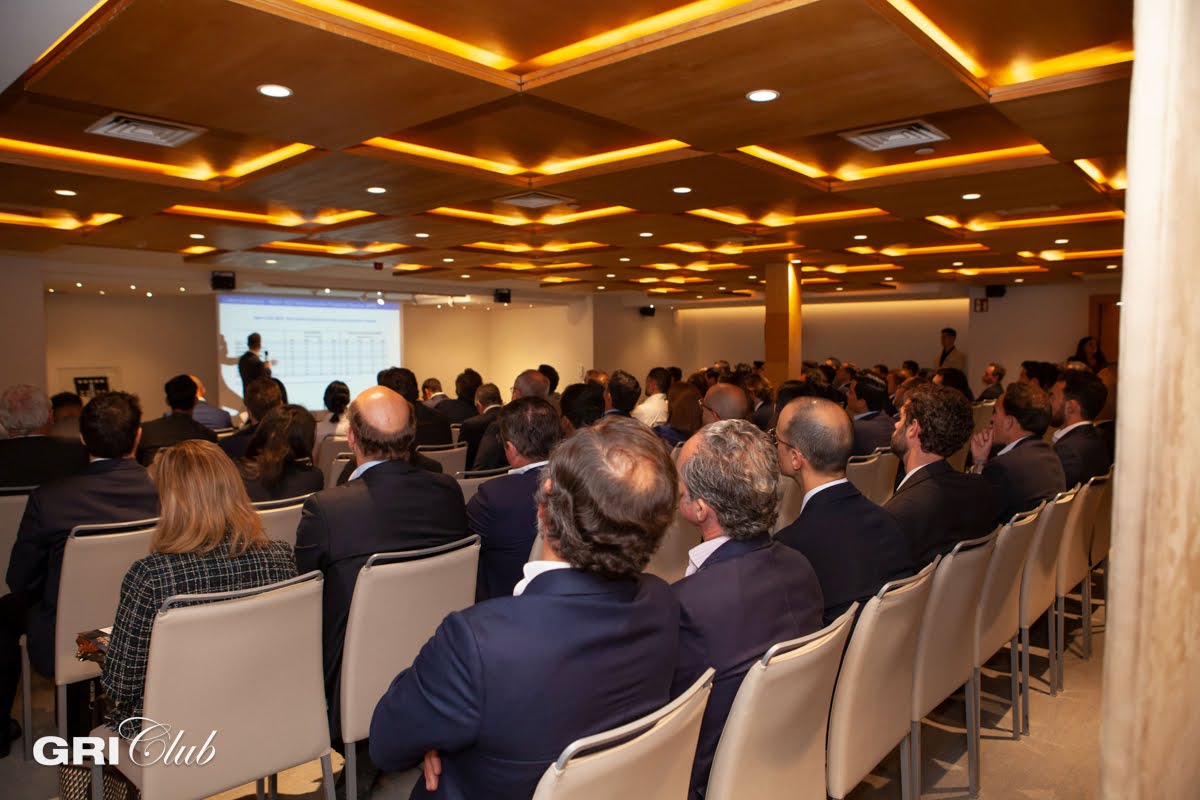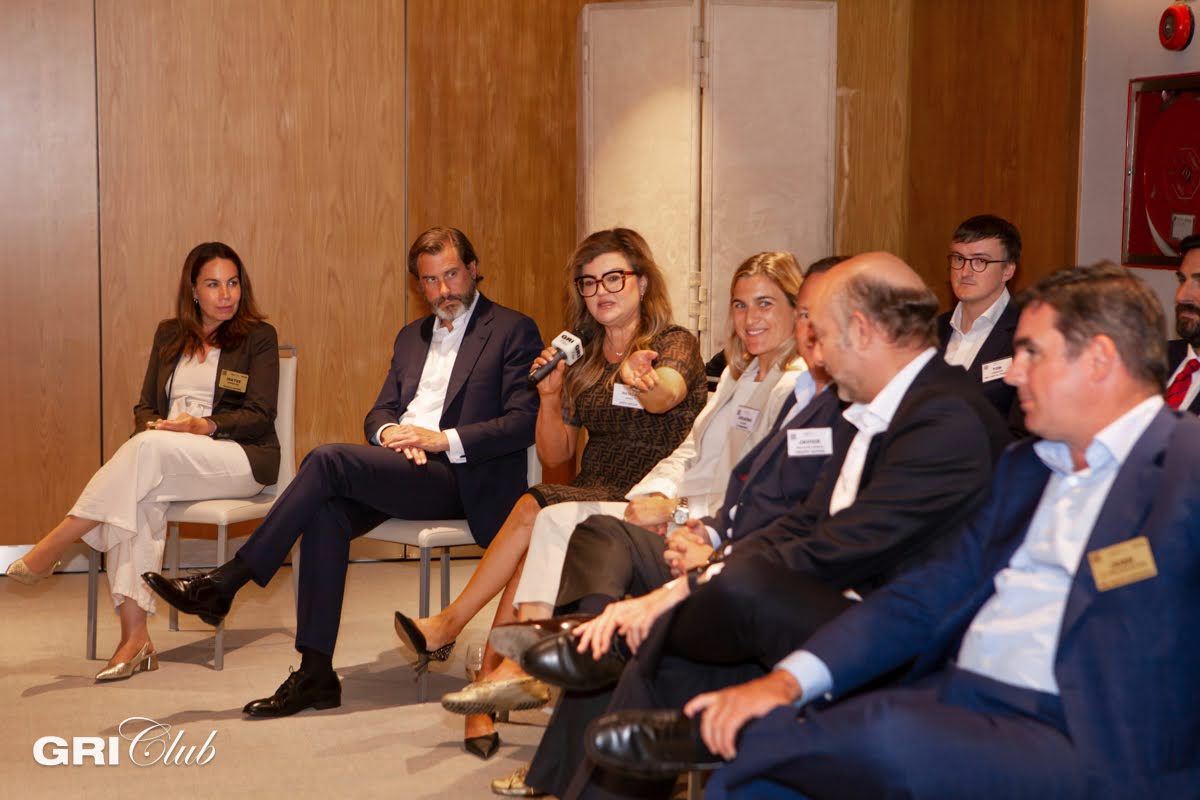 GRI Club
GRI Club Europe’s real estate leaders champion Madrid’s assets
Spain is one of the leading real estate locations in Europe. Read the report on the thoughts of the country’s real estate leaders
On 24-25 April, over 160 of Spain’s real estate decision-makers met at España GRI 2023 to discuss key themes and trends in the market, as well as the best strategies for the year going forward. This report presents all of the key takeaways for each asset class.
Gustavo Favaron, CEO and Managing Partner of GRI Club, summarised his main thoughts from the event.
“The general sentiment we saw at España GRI 2023 was that there is a ‘wait and see’ environment with many investors ready to deploy capital, but still awaiting new valuations or for signs of more economic stability.
Investors are not buying commercial real estate assets because they understand that prices do not reflect the rise of inflation and interest rates. Some reports indicate that prices could fall 40% until the end of 2024, with exceptions in Germany and Sweden, where prices have already fallen. This is not true in Spain, for now.”
Shopping & Retail
During 2022, investment in Retail real estate reached 4,450 million euros, according to JLL. It is clear from the figures that investor interest is greater than ever, as investment volume grew 310% compared to 2021, and grew even compared to 2019’s €1,750 million. This is consistent with the level of consumption by individuals in Spain, which has remained stable despite inflation and other economic concerns.In the Retail discussion at España GRI 2023, attendees started by noting that although there has been a shift in the retail paradigm from retail centres to online shopping, online business alone is not that profitable. The attendees noted that a very high percentage of online purchases are returned, while in-store sales have increased more than online sales in recent months. It was also noted that shopping malls exceed retailers in terms of net income and returns.
There is a need to differentiate between Retail and other real estate assets due to the recent shifts in dynamics, and Retail is possibly the most similar to Offices in this respect. Many are still convinced that the retail industry is in good shape, and has bounced back very well from the pandemic.
In order to facilitate more investment into Retail, more effort is required to help key investors understand the current state of the market and the success that is possible to achieve in Spain. For investors, there is a need to reinvest continuously - not just in shopping centres themselves, but also in their surroundings.
At the current moment, the property values are not commensurate with the prices offered. It is a common theme in European real estate that valuations are lagging behind. For value-added assets, it is hard to exit, but the return is interesting. Investors with a low appetite for risk are not incentivised to buy at the current prices, preferring to follow the waves.
Other ways to incentivise investors:
- Reducing operational expenditure significantly in order to make investing more viable.
- Listening to and reporting on new customers and new brands and providing different services.
- Using cross-selling techniques.
- Planning for Last Mile Logistics as it is critical for shopping centres.
- Opening at all times to retain the loyalty of the clients.
- Green variables are also increasingly important for retail assets and motivating these players.
There were also recommendations for creating portfolios in the Retail sectors of Latin American markets, which are currently evolving.

Offices
The Office sector is also well known to have been shaken over the past few years, becoming an operational asset with many functions in the present day.
Demand has shifted towards valuing quality and ESG features. The definition of good location changes over time and depends on whether it’s a bullish or bearish market.
From the owner's perspective, a tenant’s area of work matters when it comes to choosing preferable occupants. More flexibility in the market means that there is a trade-off, for example, when choosing a tenant who offers a high rent but a short period or a tenant who provides a lower rent but will stay longer.
The costs of operating from home are high, and office rents are lower in Madrid compared to London or Paris. Many companies think that it is more efficient for employees to work in the office. However, it is difficult to predict whether workers will continue to come back to the offices, or how many days per week they might be there.
Culturally in Spain, remote work is also less popular due to cultural aspects - people prefer to socialise in person.
Having multiple office locations dispersed throughout a city can incentivise employees to go back to the office. However, when it’s far from the city centre, investors are far more hesitant. Good communication is needed with these investors in order to incentivise.

From the perspective of landlords, the primary goal is to make Office assets more attractive for possible tenants. Offices are increasingly finding themselves in mixed-use spaces, as part of shopping centres and hospitality projects. The need for common spaces has increased significantly and is seen in the use of coworking facilities.
Tenants are also increasingly looking for green energy buildings, with high quality, ESG-compliant assets in non-prime locations potentially achieving higher prices than their less sustainable counterparts in prime areas. Tenants are increasingly requiring more flexibility and shorter leases.
Attendees of the Offices discussion noted that experience is becoming important in this sector and that refurbishments and retrofitting are an opportunity for creating tenant attractiveness, rental yields, and liquidity.
Investing in Spanish Real Estate
Spain is facing a new scenario with fewer, smaller-sized deals, and many are still waiting for price adjustments, which is something that was mentioned in GRI’s first large European conference of the year in February. Overall, many believe that while yields have adjusted, asking prices for land have not.Spain’s outlook is positive for the most part, as tourism recovery has been strong and sustainable, inflation and energy are controlled and lower compared to other EU nations, and the GDP growth has been high.
The assets currently available in the market do not have the prices to match an ‘opportunity’ status. The biggest challenges are interest rates, inflation, and construction cost and with this high-interest environment, one cannot make sudden decisions. The attendees hope that this year interest rates will drop to the expected levels.
The consensus in the room was that in the next 6 months, the selling activities should begin and be to the advantage of buyers. Within the next 18 months, overall market conditions should improve. However, no one has a crystal ball to predict the future so one may take these predictions with a grain of salt.
From the valuations available, many are noticing lower values; this drop in valuations, according to the executives, is coming from cap rate increases. In addition, margins are reducing, which then impacts value, leading to problems accessing finance and exit strategy issues.
Investor Landscape
Currently, executives see a new real estate market. Many are seeing an increasing lack of strict processes in favour of more market-level deals. At the current moment, the main actors from the buyer side are more equity than finance, while some investors have started to move on from the wait-and-see approach and are buying at a discount because they need to act.Land sellers are not constrained nor are they cash-strapped, which makes buying land difficult at prices where deals make sense. This comes after years of historical selling of land, but sellers now have surplus savings so they are not under pressure to sell.

Many investors are observing a different risk perception in the market owing to general uncertainty, and investors are more conservative in risk appetite compared to 2022. This is delaying many deals and reducing market activity. Portfolio balancing between different asset classes is now underway, especially by institutional investors and other big players.
General real estate feelings are positive, however. The underlying performance of assets is generally good with rental yields increasing and vacancy levels decreasing. This sector seeing high demand is because unemployment is controlled, salaries have appreciated, and households have savings.
The upcoming regulations that involve rental caps based on indexes have made investors a little more cautious; the problem is not seen to be the rental cap but instead the indecisiveness of the government, and investors would appreciate fast, clear decision-making on these issues. Some point out that rental caps on indexation can be a positive development, particularly for institutional investors.
Real estate in 2015-2021 had no competition from government bonds but now with increased interest rates, bonds are competing with the market. Yield compression is interestingly higher than in historical periods.
Important points of consideration for the current market:
- More analysis is needed with yield compression.
- The impact of urban policies, and whether it is greater;
- Quality is paramount: ESG is mandatory with users and investors want compliant assets.
Value Add and Opportunistic
The conversation in this session started with all the executives agreeing on the difficulty in finding opportunities worth pursuing currently in the market. The solution to which is just to be patient and wait for new opportunities to come to the market, as right now land prices have not gone down and costs are up.Value Add options are being considered but vendors want to sell Value Add at Core/Core+ levels, so in terms of investor return demands, these opportunities do not make sense. Investors are instead looking to be extra opportunistic, so expectations aren’t really matching the demand and supply side.
Clear visibility of the change in market volatility is needed as no one wants to make a risky move without knowing the eventual consequences.

While in 2011-2013, activity was concentrated in Retail, in the 2020-2023 period activity has been concentrated more in Residential assets such as Co-living, Student Housing and Affordable Housing, as over the next decade the housing supply needs to increase dramatically.
Alternative investment in Data Centres, Schools, and Universities is becoming a hot trend. Many are looking to these sectors to assess strategies in order to treasure hunt for deals with higher returns compared to risk profiles.
In Madrid, demand for several asset classes is high due to the good performance of the education sector, particularly universities in the city centre.
From the Cross-border investment discussion, Madrid’s Residential market emerged as a great opportunity - that is if the government does not interfere significantly in the market. However, as previously mentioned, some investors do not feel negatively about the introduction of rental caps.
There is also general consensus on Madrid being bullish about residential. Affordable housing is the key requirement for people who need it. It is important to work with the government, although Madrid’s government has been good in general terms on the progress made on making affordable housing available. The role of regulation is important for its impact on rental growth - Barcelona will also be impacted but differently from Madrid as the regional government will play a role there too.
Co-working in Madrid is also increasing in popularity from both the investor and operator sides. Aside from this primary location, Barcelona has appeared as a new player in the Offices market in the form of subletting, especially from tech companies.
Cross Border Capital
At the Cross-border Capital discussion, the executives immediately noted that deal flow is stronger in Germany and Sweden at this moment as repricing has already taken place in these markets, and as previously mentioned, this has not truly taken place in Spain as of yet. In those markets, some companies need help with senior loans owing to the Loan-to-Value thresholds and pressures on refinancing.However, inflation is lower in Spain compared to countries such as the UK and Germany, which makes the country more appealing; additionally, unemployment is under control and demand for residential is strong.

The executives also observe a change in occupier demand across major asset classes. Ground floor retail is dying, while there is a pickup in student housing, co-living and serviced living. Offices are moving from traditional to co-working models on the back of tenant demand and consumer use.
Overall, the Office outlook is positive. Some note that teleworking is not as popular in countries such as Spain due to cultural factors - it cannot be compared to the US market that has been affected more significantly, such as in San Francisco, which has been impacted by the majority of the tech sector not returning to offices as of yet.
Retail, Logistics and Residential all have exciting opportunities. Spain’s Residential market has been high performing over the last few years but still lags behind some such as Germany’s. Opportunity exists, and demand for the rental market is high in many cities with unemployment low and the barrier to buying property so high.
Retail and shopping centres were negatively affected by the pandemic, but resilience can still be seen in the market, and the circumstances have brought more creativity, awareness, and unity to the table. Retail operators and investors have been forced to rethink their strategies and focus on experience.
Some advice given to foreign investors interested in this market was to match risk profiles and appetites with the capital vehicle under their possession. Foreign investors who are IRR-driven should mitigate court decisions, as they are known to take significant time in Spain; it is best to find specific insights into the market, particularly from local experts.
On the whole, demand, structural, and cyclical changes can be overcome by being creative and innovative in decision making. Thinking differently is important and building a new perspective is key.
Hotels
The Average Daily Rates for Hotels in Spain are at a record high, and this is expected to continue next year as tourism continues to thrive post-pandemic. Meanwhile, repositioning and upgrading are key as Hospitality develops and ‘living concepts’ enter the market; the asset repositioning that has taken place so far has been successful. Hotels are considered a winner in these challenging times.
Hospitality is sometimes seen as an Opportunistic vehicle in a portfolio from a diversification perspective, however, with the recent strong performance of tourism in the country - this year is expected to see the highest tourist arrivals in Spain - it is seen as an asset with less risk. Some distress on hospitality assets but good assets get good pricing anyway. No need for it to be distressed.
Hospitality has been a good inflation hedge, as it has been possible to pass inflation on to the customer. Average Daily Rates have increased significantly, but executives are unsure that this growth will be sustained and continue over the mid-to-long term. Cost inflation pressures are a concern, while many also see the short booking window as a challenge.
There is a strong appetite for serviced apartments from all investor types. Hotel operators are looking into the extended stay space, and this area is growing but still remains small in terms of the total landscape, while there is also a huge trend in branded residences, and opportunities in midscale and lifestyle to reposition into serviced apartments on the back of Airbnb’s growth.
Residential
Renovating is expected to be a major trend and is also a major investment motive. Last year, the Spanish government also approved a plan for 1.9 billion euros to subsidise housing renovation, with a strong emphasis on making homes more energy efficient and to be funded by the EU as part of their Recovery Plan.Many investors prefer to put their money in a safer place instead of investing in residential real estate. Most understand that there is high demand for residential spaces throughout the country, as notably, younger generations are forced to rent due to not having the finances to buy. The market is also considered to be segmented. Selling is often preferred to renting, as there is a higher margin. For existing prime assets, the cost of capital is a big issue.
Additionally, there is a lack of investment from the government in social housing, and many believe there should be a more robust social housing policy to initiate more construction in this area.

There are also significant leverage limitations in this market. The borrowing cap is lower in Spain compared to other countries in Europe, while some attendees claim that more than 50% of buyers are buying with equity.
ESG comes more into focus every year in Europe, due to governmental pressure, but also pressure from investors. By 2030, 100% of the new and 50% of the old buildings need to be carbon neutral, and by 2050, this increases to 100% of all buildings. Being profitable is the top priority, but it’s not possible to raise capital if ESG requirements are not met given that investors are focusing on it.
It is key that a substitute for concrete is found with less carbon output in order to make construction viable in an ESG-focused world. Many have the impression that Spain is running out of land to build on as market prices continue to increase and the area is so profitable.
Finding the right land at the right price is key to the BTR model. The land market is predicted to become a serious problem in the coming years, as land is scarce. Most land that could have been bought up, has been bought in the last 8 years. The price of land is also not adjusted to display true market conditions. It is expected that everyone will experience difficulties finding new land in the coming years, as these plots are not anticipated to appear on the market for at least five years.
Currently, the only way to solve the problem is to make deals with landowners. However, they may not need liquidity right now and are more willing to wait until land prices rise again.
Construction costs are famously high, which creates large risks for investors that are also dissatisfied due to the shrinking IRR due to high inflation. However, for long-term players, now might be an opportune time to enter the market, and in Spain in particular there is a lower real estate bubble compared to much of Europe.
The main conclusions from the Residential discussion were that players require more land, more liquidity, and more bank and government support on their side.
Build-to-Rent
The Built-to-Rent conversation began with one of the most important themes affecting the market: regulations. Attendees emphasised that regulations need to be clear because clarity on the future is needed to plan accordingly. The best way to achieve this is to avoid staying fixed to one particular plan by adopting a flexible strategy.The final big factor for BTR is financing and the funds available in the market. The good news is that there is massive liquidity willing to enter this market, and there are more offers in the market for financing.
At the moment, there are macroeconomic headwinds that need to be catered to. The best option is partnering with different masters of crafts in the different sectors and come up with a plan together.
Currently, the risk is slightly lower right now in Spain compared to other pan-European countries. Therefore, it is ripe for investment, but the barriers to entry in the BTR world are high.
For Core assets:
- More certainty in the regulations and rates are needed so investments can be made accordingly.
- Core investments are also very focused on the Cash-on-Cash aspect of projects.
- Core investments are made for long periods of 10-20 years.

- Investors ask for rates of return of 17-20% for these projects.
- 60% of the available funding in the market is for this type of asset.
- For Value add, liquidity is considered very important as there may be no buyer if there is no player in the market who has the money to buy the asset.
Senior Living & Healthcare
Spain has one of the oldest populations in the EU, and the highest life expectancy at 83.3 years. There are approximately 9.5 million seniors today and this number is expected to reach 40 million by 2040. Some attendees of the event also claimed that the penetration of independent living in Spain is below 1%, whereas in the UK it’s around 50% and in France around 25%.There is huge demand and not enough supply for independent living. Currently, many choose the independent living option in care homes, but there is a growing trend of moving towards hospitality-like care resorts with more amenities. However, it can take some time to stabilise and operate assets such as these.
In order to convince seniors who have lived their whole life in one neighbourhood to move to a senior living facility, strong branding must be utilised, as well as experience sharing within the demographic itself.
ESG has also become a factor in this area as it is mandatory from many investors and can lead to the financing of cheaper loans. Although there are KPIs to be met in this sector, Senior Living’s tenants’ concerns about ESG are not as obvious as those of office tenants.
Student Housing & Co-living
There has been a sharp increase in the number of people studying at universities in Spain, along with an estimated 11 percent increase in the population of 18-24 year olds between 2018 and 2025, which has contributed to the development of purpose-built housing. Many students are still unable to find housing, however, and JLL has estimated that there are 380,000 students without residences.
Student housing and Co-living are designed for different stages of life because these people have different requirements. Many at España GRI believe that BTR is still the most secure asset class, and the demand will continue for Student Housing in particular as the youth population will keep increasing in Spain.
Key factors for these types of assets:
- Size of room
- Proximity to education facilities
- Affordability
- Amenities services, particularly common rooms
- Canteens are usually a low-return amenity.
Bank financing
Lenders active in the Spanish market are having difficulty closing deals due to uncertainty, with banks behaving far more cautiously, and the same goes for cross-border lenders. The recent activity in the bank sector regarding the USA’s SVB and Europe’s Credit Suisse have emphasised this hesitance.The European real estate leaders who attended the recent GRI Club discussion specifically for the SVB collapse stated that there will be repercussions. The USA is one of the biggest investors in Europe, and the loss of this capital also opens up opportunities for other areas such as Asia and the Middle East to fill the vacuum.
Europe has seen some repercussions from the banking crisis earlier this year as it has demonstrated a huge amount of focus on bank capital, and confidence is very important in this scenario. Smaller banks have suffered from nervousness, and the ECB is focused on the commercial exposure of European banks, making banks more conservative.
 Some at the event stated that they were still open to investing in almost anything apart from shopping centres. (Photo: GRI Club)
Some at the event stated that they were still open to investing in almost anything apart from shopping centres. (Photo: GRI Club) Banks are now less likely to offer financing to newcomers. They’d prefer to continue providing services to existing clients to meet the targets set by the bank, as well as the refinancing of existing assets.
The results of the EU’s latest euro area bank lending survey show that banks tightened their credit standards for loans or credit lines to enterprises in the first quarter of 2023, i.e. the percentage of banks reporting a tightening of credit standards was substantially larger than the percentage of banks reporting an easing.
Some at the event stated that they were still open to investing in almost anything apart from shopping centres, while focusing on the private rented sector the most. Overall, long-term investments cause excess expenditure and have cost issues in risk-weighted assets.
ESG and Lending
In the banking discussion, the executives noted that there is a mismatch between the financial community and developers on the line of ESG and that green loans should be cheaper but many disagree as to how much.Data has become very important in this area for energy production and consumption, as well as information gathering for due diligence analysis. It is also important to understand the market convention on the definition and certification of what is considered to be ‘green’.
For alternative lenders, the sustainable part of the market is a key area for refinancing. Nothing is currently mandatory in this area, but most do have basic requirements that are a priority to improve liquidity. Most strongly agree that ESG criteria are increasingly important for lenders and that in the future the liquidity of brown assets will decrease due to this trend.
 Many investors, especially institutional investors, are using a wait-and-watch approach. (Photo: GRI Club)
Many investors, especially institutional investors, are using a wait-and-watch approach. (Photo: GRI Club) Alternative Lending
Alternative lending is going to be key for the upcoming years compared to more traditional investments and financing. Unlike last year, when everyone was finding deals and value, it is much harder to do the same in 2023.Many investors, especially institutional investors, are using a wait-and-watch approach. More news is coming about difficulty in closing deals with current buyer and seller expectations although the situation might improve in the coming months.
We have seen that this year had more surprises. The market has much less liquidity. This comes after some years of having the market on steroids, full of operations where everything seemed to work, and when every net yield could be even more compressed.
Now with the uncertainty and rise in interest rates, we are competing with all types of financing products that have similar yields and may have less risk profiles, such as bonds and fixed incomes. On top of everything else we have sustainability, which has become the major influencer and a requirement from investors and tenants.
Many feel that banks do not want alternative lenders on the capital stack, and that it is difficult to be complementary to the bank, although not impossible. Complementary activity can be seen in some deals; most feel that an ideal situation is for an alternative lender to be a solution for the borrower so they can be both complementary or supplementary. Alternative lending can also help stabilise risky assets that can then be refinanced with the bank.
Alternative lending is adding opportunities by providing better Loan-to-Value ratios and less requirements to senior loans. Bank financing is not cheap, so alternative lending is competitive and growing. Some executives mentioned that even banks have formed alternative lending teams to evaluate opportunities.
Some attendees also mentioned refinancing opportunities in the Retail sector, as well as more specific sectors with criteria that banks do not necessarily meet.
For refinancing, a popular choice in recent months, alternative lending companies are making themselves competitive by having more cash to lend, being less cautious, and having a lower cost of debt than banks.

Finding the right structure is the real key to executing Mezzanine debt. Enforcement is the biggest difference between Europe and Spain, and in Spain, it is difficult to enforce the Mezzanine debt structure.
Light Industrial & Logistics
Last year, Spain saw one of the steepest rises in Logistics investment volume, alongside Sweden, Belgium and Portugal. Demand for logistics has remained high, and the cycle is interesting, but there are constraints, especially in Spain, such as expensive financing, high construction costs and the price of land.Ultimately, development will continue due to the high demand and the fact that it is a low-risk business. Yields are therefore correspondingly lower than other industries, although Spain’s Logistics sector had the second-highest profitability by asset class in 2022 at 4.25% just behind Hotels with a return of 4.75%.
Although last year saw good results, key Logistics players note that there were problems with asset valuations that appear to still be present and are predicted to continue. Financing is a problem with yield increasing. Rental growth is around 5-8%, but still below that of 2008.
European Logistics demand in Q1 of 2023 has returned to 2021 levels, matching the Logistics boom of 2021 and 2022. During the pandemic, the rental growth was 2-3%, and projects usually took 2-3 years to develop. Now there is a readjustment to normal demand, so it requires careful and strategic decision making. Many executives have also noticed more use of Last Mile Logistics.
From an investment perspective, deals are tight, and many have noticed low yields in Barcelona. Current high inflation rates make it difficult for landowners to lower prices. Those that are expanding across Europe are seeing low margins, and rent only represents part of profit and loss.
The attending executives concluded that the Logistics sector in Spain still has room for growth, being less developed than several other European countries. With the interest rate, if financing is 60% of the value, the cash flow model will not continue to work in the future.
New drivers for Logistics are car batteries, lithium, and Light Industrial, as well as agriculture, food, services, cold storage, and pharmaceuticals. E-commerce has grown significantly over the past several years, and Spain is in a strong position compared to the rest of the world, with scope to grow as local players come on to the scene.
Warehousing requirements have changed significantly, with considerations such as AC, insulation facilities for workers, technology, and many other aspects now being regarded as essentials, which is very different from the standards of just 10 years ago - a box.
Last Mile Logistics
Last Mile Logistics planning takes a lot of time and must be consistent. Developers need a positive approach towards Last Mile, as investment management funds are more conservative.Spain needs agility in terms of deal flow. There needs to be a friendlier attitude from municipalities, as currently, municipal governments do not lend aid to real estate and development firms.

Also, residents often complain about the noise and pollution created by Last Mile Logistics operators when they deliver their goods, which has resulted in various companies ceasing their operations in Spain.
Earlier this year, the Plenary Session of the City Council of Barcelona approved a new tax on e-commerce distribution to regulate the use of public space made by these companies. Up to this point, there was no cost to the use of public land.
The council points out that the great increase in the delivery of packages sent through major e-commerce postal operators "negatively affects traffic congestion and increased pollution, and represents an imbalance of competition with local commerce”.
In the future, real estate firms should work more closely with operations companies and be aligned to their needs, while operators should be transparent in their requirements. All parties should also focus on having energy-efficient buildings that suit their needs while converting old buildings to the new ESG standards.
The e-commerce market is expected to continue to grow, although the demand for Logistics is dependent on the culture of the population too, with many demonstrating a preference for going in-person to retail stores while others prefer online shopping. Some clients are starting to change supply chains because of sustainability requirements, and this trend is expected to continue as the government reinforces the need to be carbon-neutral.



